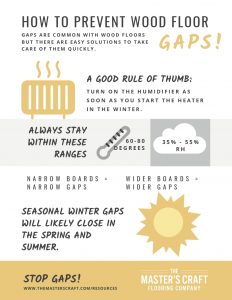Wood floor gaps happen, but what exactly is a normal movement of wood and what isn’t?
We usually see gaps show up in wood flooring during the wintertime. As the temperature drops and the need to warm our home increases, the relative humidity (RH) in our home lowers.
Decreased RH reduces the moisture content in our hardwood floors, causing the flooring to shrink.
Always Stay Within These Ranges
Industry standards, and most wood flooring manufacturers, recommend staying between 60° and 80° and RH between 35% and 55%.
To be safe, start in the middle of these recommendations and aim for 70° and 45% RH.
The key is to stay within these rates. If you could keep your home at these rates constantly, your wood flooring would not move – a tall order for sure!
When outside of the recommended range, your floor shrinks at a greater rate, creating larger wood floor gaps in the dry winter months. However, if the temperature and relative humidity swing no more than 10%, your wood floor will move very little and still be within an acceptable range.
Remember: the wider the floorboards, the larger the gaps. The narrower the floorboards, the gaps will be smaller.
How a Humidifier Can Prevent Gaps
Additionally, there are many areas of the country where the winter temperatures dip below freezing. In these areas, you will need to add additional humidity with a furnace mounted whole-home humidifier unit. If the system is installed, tested, and operating correctly, you can keep the humidity levels within the recommended range.
Without a whole-home humidifier, you are sure to see larger wood floor gaps develop and grow throughout the heating season.
As we roll into late spring and the hot summer, the humidity will rise and the floor gaps will slowly close up. When this occurs, it is considered an acceptable, normal wood floor gap.
If the gapping remains throughout the summer cooling season, you may need a flooring professional or NWFA inspector to take a closer look at what might be going on.
Natural hardwood floors give a natural beauty and warmth, connecting the homeowner organically to the land and a centuries-old trade. Being educated about how to care for this natural product will make you and your floor happier.
Need more wood floor help?
See more of our resources about squeaks, installation, and cleaning on our resources page here.
With nearly 40 years in the industry as installer, inspector, trainer, and adviser, Tim McCool is a go-to guy for all questions about wood flooring. He has multiple certifications from the NWFA, countless industry achievements, and the insight of running a flooring business.



You guys are so awesome. Thank you for all the help, insight and material you provide. My business really thrives, and my customers love the info share.